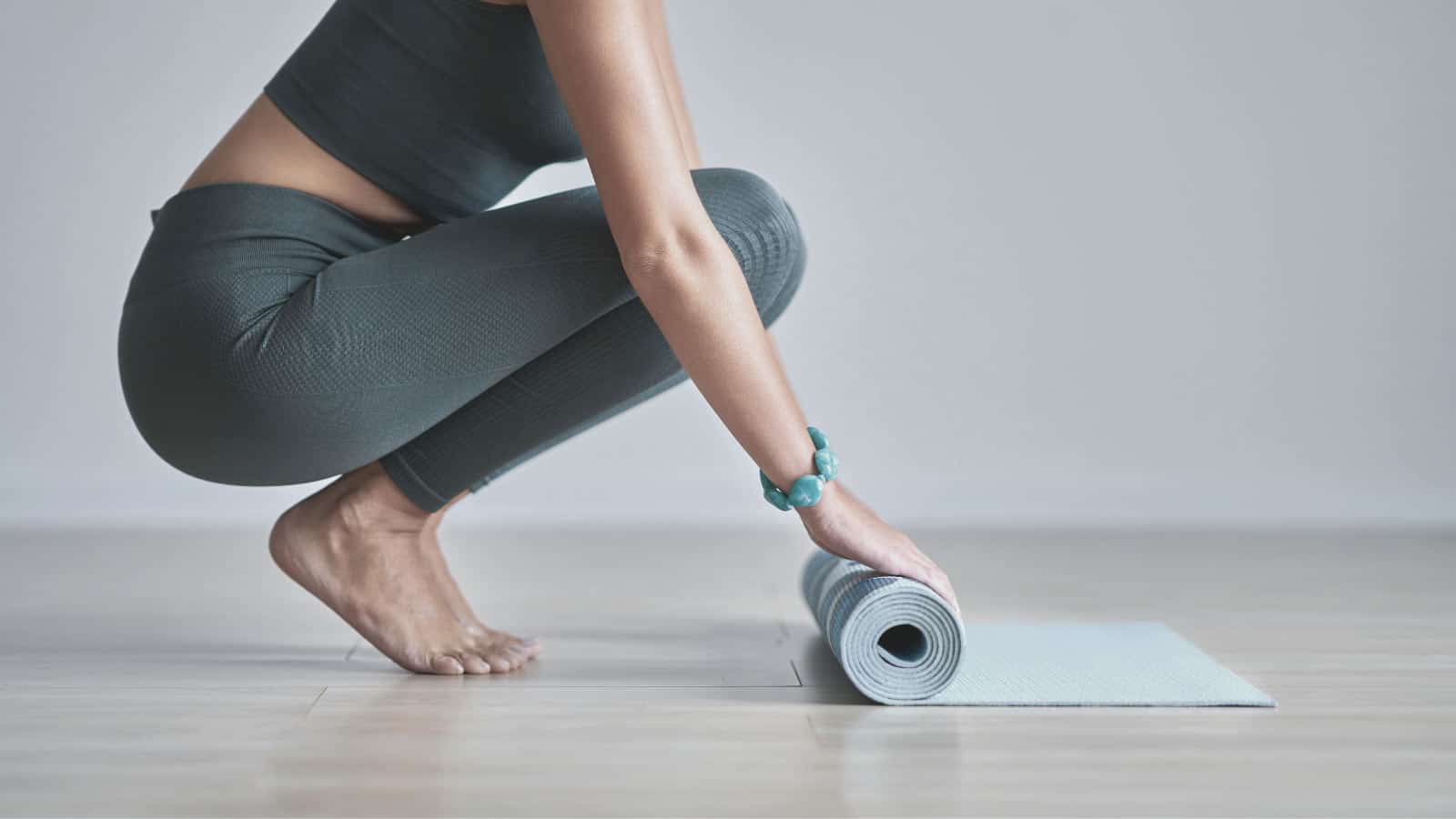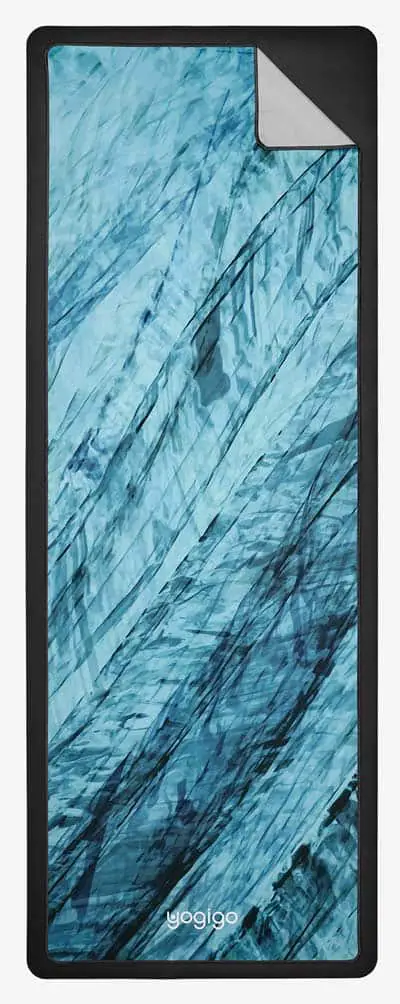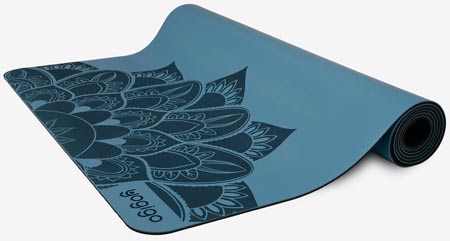A yoga mat is essential to any yoga practice. But it isn’t very pleasant when your mat doesn’t perform as expected. For instance, a yoga mat that stretches is not only annoying; it can be distracting and make practice more difficult, especially if you are compensating for the stretch in your poses.
A yoga mat stretches because the material is worn, and it’s time for a replacement. Another reason a yoga mat stretches is due to the type of material it is made from. Both the yoga mat material and the age of the yoga mat can impact overall yoga mat performance. An easy solution to avoid a stretchy yoga mat is choosing a yoga mat made of rubber or cork.
This post will discuss some solutions if you are stuck with a stretchy mat, how to avoid a stretchy mat and some important material considerations for your yoga mat.
What Should You Do About A Stretching Yoga Mat?
A yoga mat that stretches is very common. Usually, the stretching happens when your body weight is distributed at both the front and rear of the mat.
This means downward facing dog and warrior poses can be more complicated than usual. If you are not in the market for a new yoga mat, there are a few tricks to avoid a stretching mat during practice.
Try the following techniques to avoid having your yoga mat stretch out during your practice:
- Use a towel – Putting a towel (yoga towel) on top of your yoga mat may be helpful; this is very useful if you sweat a lot. The towel soaks it right up and doesn’t get your mat wet.
- Add some grip – Choosing a mat that is textured or sticky can help you keep from stretching as the mat changes with your body’s pressure.
- Spray down your mat – Some yogis suggest wetting areas that you know you’ll need a grip, like at the front and back of your yoga mat. Adding water may sound counterintuitive, but it can create more traction. Be careful, though; too much water on your mat can result in the same stretching and sliding you are trying to avoid.
What Is the Best Option to Avoid a Stretchy Yoga Mat?
Choosing a yoga mat is an important part of any practice. From beginner to expert, the yoga mat acts as your foundation. You want this foundation to be sturdy, secure and safe.
But with so many options on the market for yoga mats, it can be hard to know where to start. Avoiding a stretchy mat gets you one step closer to a completely focused, restorative practice.
Pick a Less Stretchy Material When Buying Your Yoga Mat
The best option for a sturdy, non-stretchy yoga mat is a rubber mat. These mats are generally well-priced and can be made from recycled materials, a bonus if you are trying to be environmentally conscious. Even though rubber is the best option overall for a yoga mat, there are a few other materials to consider, and some you will want to avoid.
To find the best options for a yoga mat, you have to consider a few different materials:
- Rubber – A TOP choice of material that is sturdy so as not to stretch out your yoga mat during practice; most contain latex (so avoid if you have a latex allergy)
- Cork – a more expensive option, but worth it; usually, cork topped with a foam or rubber base. The combination of materials offers increased stability and no stretching!
There are a few materials to avoid, which are known to be stretchier than other materials:
- TPE (thermoplastic elastomer) and other foams – A cheaper mat option; however, it will stretch over time during your practice, and the lifetime of the mat is not that long.
- PVC (Polyvinyl chloride) – Most common yoga mat material, latex-free but the fastest to wear out. Yoga mats made from PVC are known as “plastic yoga mats.” You would want to avoid them if you care about the planet.
- Natural fabrics – Cotton and jute; since these mats are naturally woven, they may stretch as you plant your hands and feet; avoid using on a wooden or tiled floor as in addition to stretching, you might be sliding.
Thicker Yoga Mats Stretch Less
Most of the time, the thickness is overlooked when buying a yoga mat. This is not something you want to ignore. Considering thickness is not only important for joint comfort, but thicker mats tend to not stretch as much as thinner mats.
There are a few more common thicknesses out there. Here are some comparisons between them:
- Thin – appx 1.5 mm, or 1/16 inches thick:
Pros: Great for travel because they are lightweight and space-saving;
Cons: Depending on the material, can wear out very quickly (especially PVC) and stretch easily.
- Standard – appx 3 mm, or 1/8 inches thick:
Pros: Sturdy and stable, won’t get caught as you move into different poses, easy to carry around, not too heavy;
Cons: Usually this is the most desired thickness of yoga mats, but for some people might have not enough cushioning.
- Thick – appx 6 mm, or around ¼ inch thick or more:
Pros: More cushion for the joints, usually have a longer life because they are durable and can take more wear;
Cons: Could be too heavy to carry from home to yoga studio, therefore more suitable for keeping at in place (for example home).
Yoga Mat Texture and Grip Figure Into Stretchiness
In addition to material and thickness, the texture of your yoga mat can influence the stretchiness of the mat.
You want to select a mat that is textured, but not an uncomfortable or distracting surface.
Generally, a textured mat provides a decent grip, which is important to keep your yoga mat from stretching underneath you.
The following are a few options for textured yoga mats that provide grip:
- Raised bumps – Very common among yoga mats of all material types
- Most PVC (plastic) yoga mats are popular because of good grip and low price, but they are also toxic for the practitioner and environment. (Note: We mention them here because they are available in the market, but we encourage everyone to read more about the impact of PVC yoga mats on the environment before investing in one).
- Woven materials – Can be gentler on the hands and feet; however, the fiber and weave used will significantly impact comfort level; holding poses for long periods on a woven texture may prove painful on the palms.
A Breakdown of the Best of the Best to Avoid a Stretchy Yoga Mat
To avoid a stretchy yoga mat, there are many solutions and options. Since each of these characteristics was covered in detail above, it seemed easy to conclude with the top choices to avoid a stretchy yoga mat. Below are the best options for grip and texture, thickness, and material to consider when looking for a non-stretchy yoga mat.
Best Grip for Your Yoga Mat: Natural Rubber Yoga Mat
- Doesn’t shift underfoot
- Sturdy material
- Easily washable
- Superb stickiness
- No sliding or stretching
Best Thickness for Your Yoga Mat: Standard to Thick Mats
- 3 – 6 mm (1/8 – 1/4 inches) are going to be best to avoid stretching
- Won’t stretch because of extra material
- Great padding for knees, hands, and feet
Best Material for Your Yoga Mat: Natural Rubber Yoga Mat, Again!
- No-slip
- Great grip
- Least likely material to stretch and move during practice
- Usually thicker, adding to its sturdiness
- Natural Rubber base, PU top yoga mat
- PU is knows as a vegan leather
- Least likely material to stretch and move during practice
- Natural rubber base sticks well on the floor, and PU top provides excellent grip
- Minimum thickness advised to avoid stretching: 3.5 mm, or 1/8 inch
Natural Rubber base, Microfiber top yoga mat
- Microfiber top absorber sweat and provides perfect grip if/when palms are wet
- Won’t stretch because of microfiber material on the top
- Natural rubber base will keep yoga mat “glued” on the floor
- Minimum thickness advised to avoid stretching: 3 mm, or 1/8 inch
In Summary
A stretchy yoga mat is an annoying and distracting problem to have during your yoga practice. But there a few simple solutions to remedy a stretchy mat. And if you are in the market for a new mat, there is a lot to consider in order to avoid purchasing a stretchy yoga mat.
In all, a yoga mat made of rubber will keep you firmly in your poses without being uncomfortable or causing difficulties with balance. This is the best option for a non-stretchy and no-slip yoga mat. Choosing a yoga mat that doesn’t stretch will eliminate common worries and help you focus on your practice!










